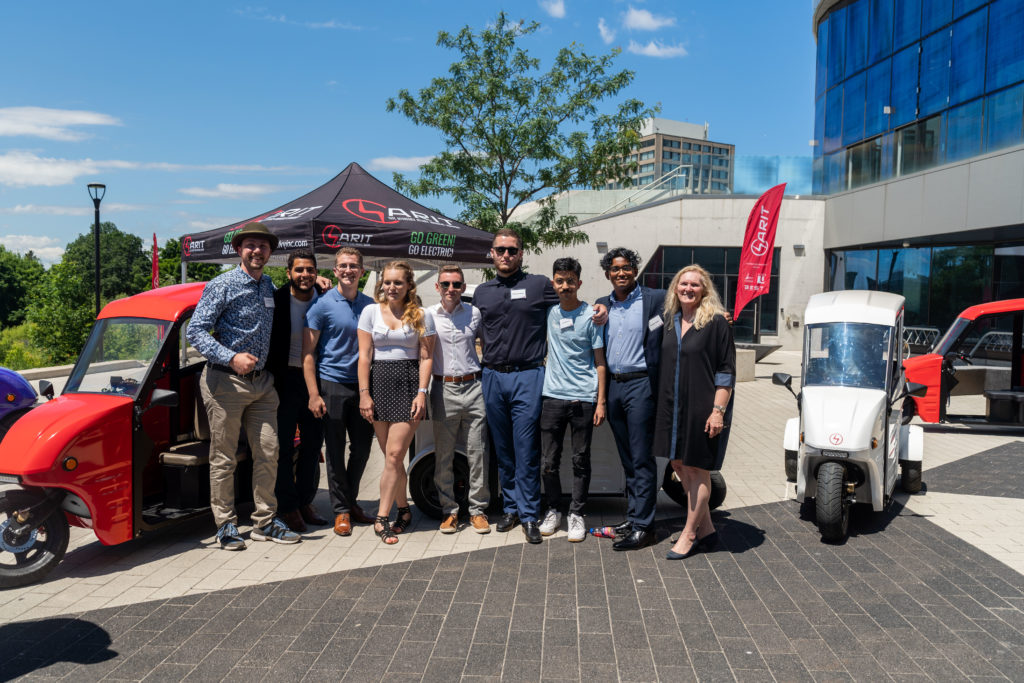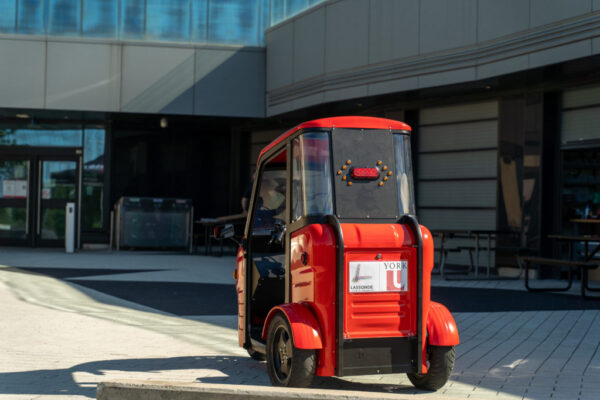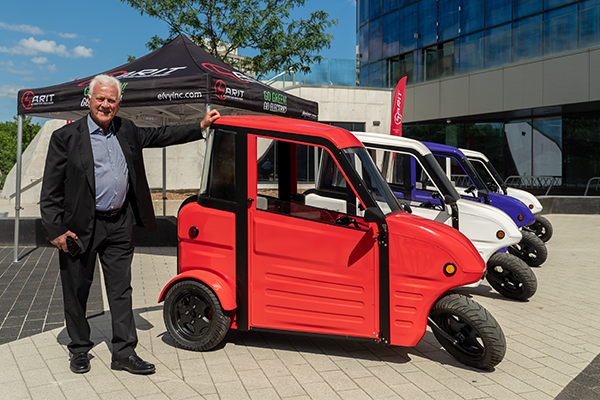York U a ‘living lab’ for auto magnate Frank Stronach’s prototype electric cars
Tags:

This story originally appeared on the York University News Website.
In the spring of 2021, when auto magnate Frank Stronach announced his intention to launch a tiny three-wheeled electric commuter car to reduce greenhouse gases, ease traffic jams and solve parking problems, York University’s Prof. Andrew Maxwell saw an opportunity.
What if York U’s campus became a “living lab” to test the prototype SARIT (Safe, Affordable, Reliable, Innovative Transit) vehicles the billionaire Magna International founder hoped was the future of sustainable commuter transportation?
Maxwell picked up the phone and left a message.
“We were looking for a sustainability project on campus, and we already had a bunch of things going on with electric vehicles, so I thought this is a really cool idea,” says Maxwell, who is the Bergeron Chair in Technology Entrepreneurship at York’s Lassonde School of Engineering.
A former governor of York U, Stronach was already well connected to the University, and the SARIT’s production facility was located in Aurora, less than an hour’s drive from Keele Campus.
“I said, ‘Here’s the idea’ and he said yes,” Maxwell recalls. “It was like he built this vision within 10 minutes and took massive leaps forward. He said, ‘Let’s test it there, let’s do research there. Let’s build a living lab, a dealership.’ It was like bang, bang, bang, and everything we said in that first conversation we’re actually putting into practice.”

Stronach delivered the first prototype to the Lassonde School in April, and the work began immediately. Ever since, faculty, students and campus-facilities staff in the “mini-city” of Keele Campus have been putting their heads together to realize the potential of Stronach’s vision for the SARITs.
And now Stronach has demonstrated his commitment to the initiative by way of a $100,000 gift, which was announced on June 23 at an event at Lassonde’s Bergeron Centre for Excellence in Engineering, after Stronach arrived on campus with another batch of SARIT prototypes for students, faculty and staff.

The funds are part of wider partnership between Stronach and the University, which will support research-funding opportunities in sustainable urban agricultural and, of course, the continued testing, development and improvement of the SARIT electric vehicle prototypes on an ongoing basis in York’s living lab.
“When we look back at history, change has always been brought about by students, and we need a culture change,” Stronach said at the June 23 announcement. “When I look three years down the road, gasoline prices will triple. When I look 10 years down the road, gasoline will be rationed.”
Although large electric cars have been rising in popularity – especially with sky-rocking gas prices – Stronach says large electric vehicles don’t address gridlock, and it will take trillions of dollars to build up the grid system to accommodate widespread use.
With jurisdictions including California, the European Union and Canada, moving towards a ban on gasoline-powered vehicles by 2035, Stronach says micro-mobility is the solution. His SARITs surely won’t be the only to market, but he’s hoping to be the first out of the gate.
“Micro-mobility in broad terms means, you should be able to park four in a regular parking spot. To be more definitive, it cannot be wider than 3.5 feet, not longer than 7.5 feet because two of those vehicles should be able to drive side by side on a regular road.”
Indeed, the SARIT initiative aligns with York’s demonstrated commitment to the U.N.’s Sustainable Development Goals, specifically sustainability, for which the university was recently ranked in the Top 10 among the world’s universities on the Times Higher Education Impact Rankings.
“The deployment of these micro-mobility electric vehicles will leverage York’s commitment to entrepreneurship and sustainability,” said Rhonda Lenton, York’s president and vice-chancellor. “Now more than ever, universities are being called upon to provide transformative leadership that bridges partners across institutions, sectors and borders to maximize our collective impact, and York is committed to bringing all of our resources to help ensure a fairer, more just, and more sustainable future for all.
“I want to thank Frank Stronach and Stronach International for his generous gift, for investing in our students, and for trusting York with this important partnership. I am so proud of what this partnership will do to drive positive change for our communities.”
Maxwell describes the SARIT work as a flagship research project. It’s a collaborative endeavour that involves faculty, students and more than two dozen York Facilities staff, who are running real-life tests of the cars through their work in areas such as maintenance, security and parking.
“The SARIT project will become iconic for sustainability, innovation, social issues, living labs, and work-integrated learning.”
— Andrew Maxwell, Bergeron Chair in Technology Entrepreneurship, Lassonde School of Engineering
“They’ll test things like how fast they accelerate, how fast they are and how they can be used,” says Maxwell. “We want to see what the issues are.”
Students – both undergraduate and graduate – are testing applications for the vehicles beyond campus staff transportation, including their suitability for ride sharing and for use by people with disabilities.
A planned prototype dealership on campus will also give York researchers an opportunity to do market research that will help determine whether consumers will want to lease or own the vehicles and whether the market will bear Stronach’s anticipated price tag of $6,000-$7,000.
There are also plans for a pickup-truck prototype that can haul 300-400 pounds of material and would retail for: $7,000-$8,000.
The arrival of Stronach’s micro-mobility prototypes has brought a huge energy to a campus that places high value on sustainability, innovation and collaboration for societal good.
“The mood is fantastic – people are so positive and pumped,” says Maxwell, adding that 28 students applied for six research opportunities to work on the project, more than 50 students signed up for a “hackathon” to come up with new research ideas involving the SARIT, and “we got a real buzz with the staff.”

Nick Di Scipio, who recently completed his fourth year of mechanical engineering at Lassonde, says excitement about the project began to mount the day in April when Stronach showed up on campus with the first SARIT prototype.
“Just being there in his presence and seeing what was coming to campus was really exciting, and then I find out a few months later that I was chosen to work on this project,” he says.
“Frank is a very visionary person, so just being around him, being a part of this is very exciting for everybody involved.”
Di Scipio worked on experiments with pedestrian detection technology for the cars that could add an accessibility feature by giving the driver an audible warning if people are in their vicinity. He also participated in testing different lithium batteries that use a variety of chemical mixtures to see how they perform in the SARIT.
Now, Di Scipio has been offered an internship at Stronach’s company, so his work on the SARIT will continue.
“The main thing I see coming out of a project such as this one is seeing how sustainable technologies can come in many different shapes and sizes and how the future of transportation is really changing to benefit people and move away from what we’re currently using that creates issues like climate change,” says Di Scipio.
He says what he’s learning on the project is just as important as what he picks up in the classroom.
Artem Solovey, who is in the second year of a master’s degree in transportation engineering, says he has had other experiential learning opportunities through York, but none as meaningful as the chance to work as a researcher on an innovative real-life project involving someone as forward-looking as Stronach.
“There is something very special about being part of something that will be so big in the future,” Solovey says. “It allows you as an engineer to consider the business side and collaborate with other teams on other aspects, and that’s a perfect recipe for creating something very impactful. It can really change a person into becoming something really great.”
The micro-mobility cars, which can fit one or two people, span 3.5 feet wide and 7.5 feet long. Four fit into a single parking spot.
Maxwell says, as well as being sustainable, they have potential to “democratize” transportation because of their low cost and potential for use by people with disabilities.
The first 100,000-20,000 vehicles will roll off the lot of Stronach’s facility in Aurora by the end of 2022. Ontario’s Transportation Ministry has given municipalities the green light to decide for themselves whether they can be used on roads or sidewalks, or even bike lanes.
In the meantime, Stronach’s investment in his collaboration with York has had tangible effects, creating research opportunities for faculty and students, experiential learning, co-ops and potential jobs. It is also helping York to fulfil its commitment to building a more sustainable world.
“This will become iconic for sustainability, innovation, social issues, living labs, and work-integrated learning,” says Maxwell.
“We have a four-year partnership, and there’s no reason why it should stop there.”
Watch the promotional video.